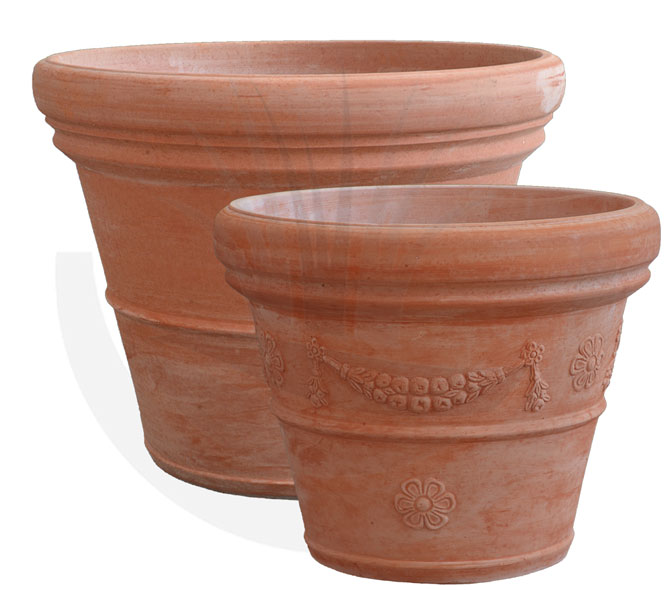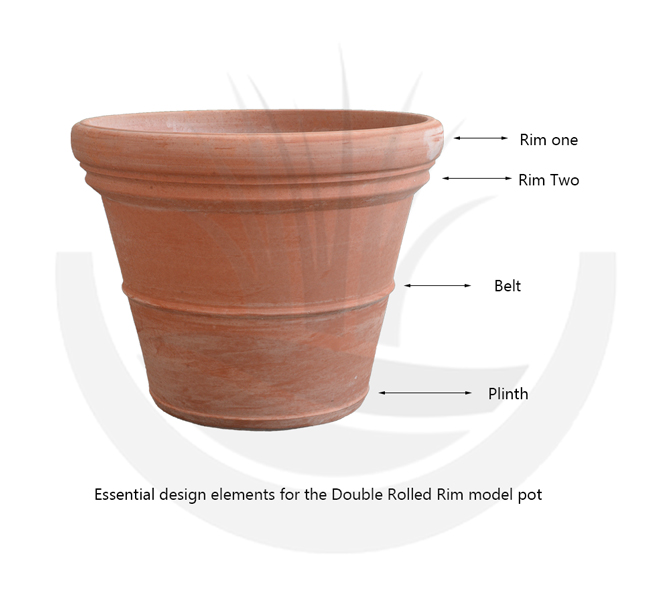
When we talk about a terracotta pot, our mind certainly goes to a round container with a truncated cone shape and a smooth surface. These are the
characteristics of a Tuscan pot, a classic from the 70s that has achieved and continues to have enormous success, so much so that the main sales
of every terracotta pot factory concern precisely this model. But why has this pot found such approval in the market? Let's try to give our humble
interpretation.
Let's delve into some economic history. It may seem strange and even impossible, yet the great boom of terracotta pots occurred in the 70s.
Before 50 years ago, although terracotta has ancient roots, the production of terracotta was mainly for construction, or objects that served
everything except to embellish the house and garden. Besides bricks, siphons, and other pipe elements for drainage, jars for storing olive oil,
and basins (read: containers) used by women to do laundry were also manufactured. No aesthetic use, no flower containers. At most, it was a luxury
that few wealthy people could afford. With prosperity came the need to make the home more beautiful and welcoming, and terracotta kilns began to
change the type of production. After all, pipes were made of plastic and families washed their clothes with modern washing machines.
If it was not the first model, the double-rim pot (or simply Rolled Rim Pot) immediately found a good market. With its simple, functional but also elegant design, it lent itself well as a plant container. The two upper rims, the first of which is more important, are interrupted by a groove that makes a good handle to move the pot, especially in winter to protect the plants, usually lemons. The truncated cone shape facilitates the removal and transfer of the plant to a larger pot, and the fairly wide base makes the pot much more stable than its Impruneta brothers. Even from a production point of view, the round pot is easier and faster to produce. The double-rim pot can be produced almost mechanically. In fact, with the modine lathe, making the inside of the pot becomes fast, precise, and simple. Firing the pieces also becomes cheaper because the shape of the double-rim pot lends itself well to inserting one pot inside the other, saving space in the kiln and the cost of firing, as well as for the preparation of the package and its shipment.
The design elements of the double-rim pot are the two rounded upper rims, of which the first is much thicker than the second; let's call them rim one and rim two. A belt is positioned approximately in the middle of the pot, which has no practical relevance, only aesthetic, as well as the base plinth. There are variations in the theme but not in the elements. Rim one can be further embellished with a square finish, and rim two can have other movements. The belt can be doubled or tripled, and the base plinth can have an additional rim. In the photos, you can see various examples of what I just told you.
The smooth Tuscan pot par excellence is undoubtedly the double rolled rim model. The name derives precisely from the two upper rims, one external larger and more important, the second smaller highlighted by a channel that distances it from the first. Curiously, the canal was used to handle in moving the pot.
The sizes range from 25 cm to 180 cm in outer diameter. They are spaced about 5 centimeters apart up to about 70 cm, and then about 10 centimeters apart up to 120 cm. Pieces larger than 120 cm are not very marketable and factories mainly use these giants to have a representative item in their catalog of the value of their craftsmanship.

The classic design of the double rim vase also has a variation known as the "festoon" (or Garland) a kind of Baroque embellishment. We will discuss this in more detail in another article, but for now it suffices to know that this element is present in Baroque architecture and is often found in Roman art as a decorative element. The term "festoon" comes from the Latin word "festus," meaning festive or celebration. Flowers, fruits, leaves, and other items are used, and when held up at both ends, it can be hung as an ornament on windows, balconies, or ceilings. The Garland is the transfer of naturalistic decorative elements from art (painting and sculpture) into other forms, and terracotta artisans have incorporated this decoration into vases, making it one of the classic decorations for all shapes and models, not just for the Rolled Rim Pot.
| Product Infos |
|---|
| Description: Rolled Rim Pot |
| Made in: By now, the whole world |
| Raw material: Terra di Siena, Galestro, Impruneta |
| Production technique: Hand Cast, Lathe Cast, Gypsum Press, Metal Press |
| Finishing: Sponged, Scratched, Aged |
| Color: Terracotta, Aged, Etrusca, any colors |
| Available Sizes: 25 to 180 outer centimeters |

